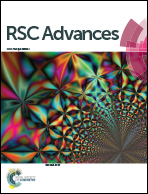Evidence for charge-induced dipole reaction in laser ionized van der Waals clusters: a case of Fe2+ reacting with argon atoms inside a cluster
Abstract
Fe(CO)5-doped argon clusters have been photo-ionized by 532 nm, nanosecond laser pulses and the ions generated as a result of laser–cluster interaction were detected using time-of-flight mass spectrometry. Formation of [FeAr]+ was observed to coincide with generation of Fe2+. Reaction of singly charged iron ion (Fe+) with argon did not give rise to a detectable amount of [FeAr]+. However, for the Fe2+ case, the yield of [FeAr]+ is found to depend on the laser intensity and size of the argon cluster. Density functional theory calculations suggest that the reaction of Fe2+ with Ar dimer is energetically 4 times more favorable for generation of [FeAr]+ as compared to the reaction of Fe+ with Ar. Based on the intensity of different ions, two orders of magnitude enhancement in the rate constant has been estimated for the reaction of iron ion towards argon with a change of ionic state from singly charged to doubly charged. The present experimental and theoretical studies demonstrate the existence of an additional and efficient intra-cluster reaction channel based on charge-induced dipole reaction for generation of [FeAr]+ from the photo-ionization of Fe(CO)5-doped argon clusters.


 Please wait while we load your content...
Please wait while we load your content...